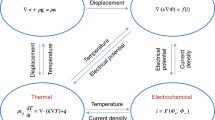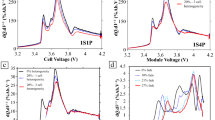Abstract
To accelerate the development of safe, reliable, high-performance, and long-lasting lithium-ion battery packs, the automotive industry requires computer-aided engineering (CAE) software tools that accurately represent cell and pack multi-physics phenomena occurring across a wide range of scales. In response to this urgent demand, General Motors assembled a CAEBAT Project Team composed of GM researchers and engineers, ANSYS Inc. software developers, and Professor Ralph E. White of the University of South Carolina and his ESim staff. With the guidance of NREL researchers, the team collaborated to develop a flexible modeling framework that supports multi-physics models and provides simulation process automation for robust engineering. Team accomplishments included clear definition of end-user requirements, physical validation of the models, cell aging and degradation models, and a new framework for multi-physics battery cell, module, and pack simulations. Many new capabilities and enhancements have been incorporated into ANSYS commercial software releases under the CAEBAT program.
Access this chapter
Tax calculation will be finalised at checkout
Purchases are for personal use only
Similar content being viewed by others
References
Kim GH et al (2011) Multi-domain Modeling of lithium-ion batteries encompassing multi-physics in varied length scales. J of Electrochem Soc 158(8):A955–A969
ANSYS (2014) Fluent 15.0 user’s guide. Ansys Inc.
Kwon K, Shin C, Kang T, Kim CS (2006) A two-dimensional modeling of a lithium-polymer battery. J Power Sources 163:151–157
Kim US, Yi J, Shin CB, Han T, Park S (2011) Modeling the dependence of the discharge behavior of a lithium-ion battery on the environmental temperature. J Electrochem Soc 158(5):A611–A618
Kim US, Shin CB, Kim C (2008) Effect of electrode configuration on the thermal behavior of a lithium-polymer battery. J Power Sources 180(2):909–916
Chen M, Rincon-Mora GA (2006) Accurate electrical battery model capable of predicting runtime and I–V performance. IEEE Trans Energy Convers 21(2):504–511
Doyle M, Fulle T, Newman J (1993) Modeling of Galvanostatic charge and discharge of the lithium/polymer/insertion cell. J Electrochem Soc 140(6):1526–1533
Cai L, White RE (2009) Reduction of model order based on proper orthogonal decomposition for Lithium-Ion battery simulations. J Electrochem Soc 156(3):A154–A161
Smith K, Wang CY (2006) Solid-state diffusion limitations on pulse operation of a Lithium ion cell for hybrid electric vehicles. J Power Sources 161:628–639
Li G, Li S (2014) Physics-based CFD simulation of Lithium-ion battery under the FUNS driving cycle. In: ECS transactions, October 5–9, Cancun, Mexico
Guo M, White RE (2013) A distributed thermal model for a Li-ion electrode plate pair. J Power Resour 221:334–344
Thomas K et al (2001) Measurement of the entropy of reaction as a function of state of charge in doped and undoped lithium manganese oxide. ECS J 148(6):A570–A575
Holman J (1976) Heat transfer. In: Section 4.2, “lumped heat capacity system”, 4th edn. McGraw-Hill
ANSYS Battery Design Tool User’s Manual, ANSYS, Inc., Version 1.0, 2014
Grimme EJ (1997) Krylov projection methods for model reduction, Doctoral dissertation, University of Illinois at Urbana-Champaign
Hatchard TD et al (2001) J Electrochem Soc 148:A755–A761
Kim GH, Pesaran A, Spotnitz R (2007) J Power Sources 170:476–489
Spotnitz RM et al (2007) J Power Sources 163:1080–1086
Smith K et al (2010) Int J Energy Res 34:204–215
Santhanagopalan S, Ramadass P, Zhang J (2009) J Power Sources 194:550–557
MacNeil DD, Dahn JR (2001) J Phys Chem A 105:4430–4439
Bayarri MJ et al (2007) Technometrics 49:138–154
Bayarri MJ et al (2007) Ann Stat 35:1874–1906
ASME PTC 60 (2006) ASME V&V 10 guide, New York
Han T, Tselepidakis D, White RE (2015) Development of computer aided design tools for automotive batteries. GM CAEBAT Project – Final report, prepared for subcontract No. ZCI-1-40497-01 under DE-AC36-08GO28308, October 2015
Acknowledgments
Original work performed under Subcontract No. ZCI-1-40497-01 under DE-AC36-08GO28308. This work would not have been possible without the support and guidance of many people. The authors wish to thank Brian Cunningham from the Vehicle Technologies Program of the DOE for funding support and guidance. We also wish to thank Gi-Heon Kim and Ahmad Pesaran from NREL for their contributions to the CAEBAT program by providing consultations as a technical monitor of the project. Finally, we express appreciation for the contributions from the following colleagues: Saeed Asgari, Steve Bryan, Jing Cao, Kuo-Huey Chen, Lewis Collins, Erik Ferguson, Amit Hochman, Sameer Kher, Genong Li, Shaoping Li, Justin McDade, Sorin Munteanu, Ramesh Rebba, Victor Sun, Dimitrios Tselepidakis, Michael Tsuk, Jasmine Wang, and Erik Yen.
Publications and Presentations
-
1.
Taeyoung Han, Gi-Heon Kim, Lewis Collins, “Multiphysics simulation tools power the modeling of thermal management in advanced lithium-ion battery systems,” ANSYS Quarterly magazine “Advantage”, 2012.
-
2.
Taeyoung Han, Gi-Heon Kim, Lewis Collins, “Development of Computer-Aided Design Tools for Automotive Batteries-CAEBAT,” Automotive Simulation World Congress (ASWC), Detroit, October 2012.
-
3.
Xiao Hu, Scott Stanton, Long Cai, Ralph E. White, “A linear time-invariant model for solid-phase diffusion in physics-based lithium ion cell models.,” Journal of Power Sources 214 (2012) 40–50.
-
4.
Xiao Hu, Scott Stanton, Long Cai, Ralph E. White, “Model order reduction for solid-phase diffusion in physics-based lithium ion cell models,” Journal of Power Sources 218 (2012) 212–220.
-
5.
Meng Guo, Ralph E. White, “A distributed thermal model for a Li-ion electrode plate pair,” Journal of Power Sources 221 (2013) 334–344.
-
6.
Ralph E White, Meng Guo, Gi-Heon Kim, “A three-dimensional multi-physics model for a Li-ion battery”, Journal of Power Sources, 2013.
-
7.
Saeed Asgari, Xiao Hu, Michael Tsuk, Shailendra Kaushik, “Application of POD plus LTI ROM to Battery Thermal Modeling: SISO Case, to be presented in 2014 SAE World Congress.
-
8.
Xiao Hu, Scott Stanton, Long Cai, Ralph E. White, “A linear time-invariant model for solid-phase diffusion in physics-based lithium-ion cell models.,” Journal of Power Sources 214 (2012) 40–50.
-
9.
M. Guo and R. E. White, “Mathematical Model for a Spirally-Wound Lithium-Ion Cell,” Journal of Power Sources 250 (2014), also presented at the ECS meeting, spring 2014, Orlando, FL.
-
10.
R. Rebba, J. McDade, S. Kaushik, J. Wang, T. Han, “Verification and Validation of Semi-Empirical Thermal Models for Lithium Ion Batteries,” 2014 SAE World Congress, Detroit, MI.
-
11.
G. Li, S. Li, “Physics-Based CFD Simulation of Lithium-Ion Battery under a Real Driving Cycle”, Presentation at 2014 ECS and SMEQ Joint International Meeting, Oct 5–9, 2014, Cancun, Mexico.
-
12.
G. Li, S. Li and J. Cao, “Application of the MSMD Framework in the Simulation of Battery Packs”, Paper IMECE2014–39882, Proceedings of ASME 2014 International Mechanical Engineering Congress & Exposition, IMECM 2014, Nov 14–20, 2014, Montreal, Canada.
-
13.
Y. Dai, L. Cai, and R. E. White, “Simulation and Analysis of Inhomogeneous Degradation in Large Format LiMn2O4/Carbon Cells,” Journal of The Electrochemical Society, 161 (8), 2014.
-
14.
T. Han, G. Kim, R. White, D. Tselepidakis, “Development of Computer Aided Design Tools for Automotive Batteries,” ANSYS Convergence conference, Detroit, MI, June 5, 2014.
-
15.
T. Han, M. Fortier, L. Collins, “Accelerating Electric-Vehicle Battery Development with Advanced Simulation,” Aug 21, 2014, Webcast seminar organized by SAE International, http://www.sae.org/magazines/webcasts .
Author information
Authors and Affiliations
Corresponding author
Editor information
Editors and Affiliations
Rights and permissions
Copyright information
© 2023 This is a U.S. government work and not under copyright protection in the U.S.; foreign copyright protection may apply
About this chapter
Cite this chapter
Han, T., Kaushik, S. (2023). Development of Computer Aided Design Tools for Automotive Batteries. In: Santhanagopalan, S. (eds) Computer Aided Engineering of Batteries. Modern Aspects of Electrochemistry, vol 62. Springer, Cham. https://doi.org/10.1007/978-3-031-17607-4_4
Download citation
DOI: https://doi.org/10.1007/978-3-031-17607-4_4
Published:
Publisher Name: Springer, Cham
Print ISBN: 978-3-031-17606-7
Online ISBN: 978-3-031-17607-4
eBook Packages: Computer ScienceComputer Science (R0)




